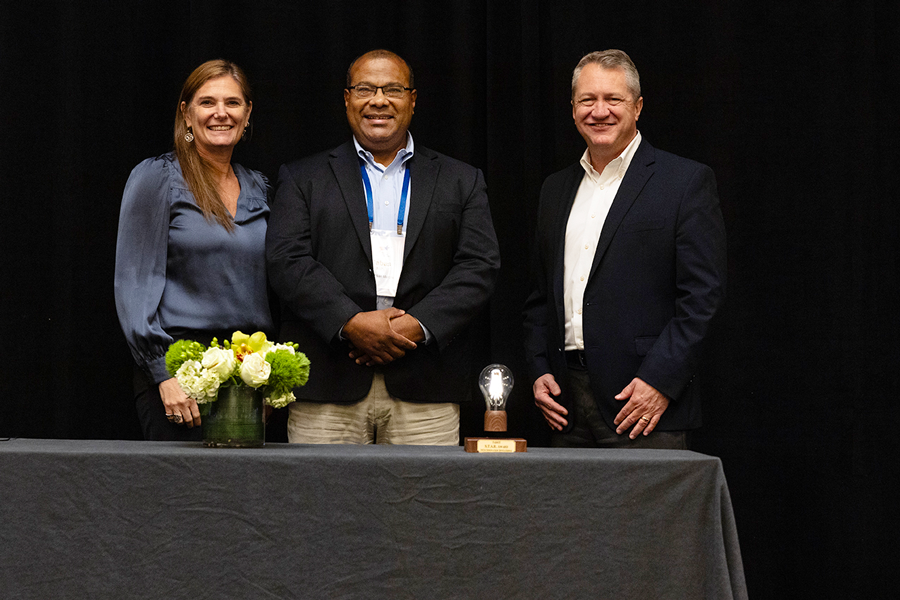The Innovation Invitational creates a forum for local government teams to share innovative projects they are developing for grant opportunities. Participating teams identify regional challenges and present solutions at the conference before a panel of experts who consider the projects for the STAR (Smart Transportation & Advanced Roadway) award and an opportunity to receive up to $125,000 in grant funds. The 2024 Innovation Invitational was hosted by TxDOT and the UT Center for Transportation Research (CTR) at the Grand Hyatt River Walk in San Antonio.
Winners of the 2024 STAR award:
- Team El Paso - El Paso International Port ITS Design
- Team Permian Basin - Permian Corridor Assessment and Mitigation
- Team San Marcos - Developing a Train Detection and Alert System Using Google AI and Cloud
STAR award winners
Team El Paso
El Paso International Port ITS Design
Project Location: Bridge of the Americas and Ysleta Port of Entry
Project Abstract: The City of El Paso plans to develop an integrated ITS system at four ports of entry to support real-time information for commercial traffic, transit, and multimodal at the crossings. The project is supported by the U.S. Department of Energy NREL Laboratory, the ASPIRE NSF Engineering Research Center, local universities, and three levels of government in both the United States and Mexico. This proposal would supplement the ITS work by installing low-cost sensors at ports of entry and across the network to monitor air quality and idling vehicles.

TxDOT leaders join Team El Paso on stage to receive the STAR award at the 2024 Innovation Invitational.
Presenter: Omar Martinez, Assistant Director of Legislative Affairs, City of El Paso Primary Technology Areas
Project lead: City of El Paso
Project partners: TxDOT El Paso District, Texas A&M Transportation Institute, El Paso MPO: Smart Infrastructure, Data
Challenge definition and background
El Paso is a confluence of cultures and commerce. Home to six Ports of Entry (POEs) that are responsible for processing $109+ billion in U.S.-Mexico trade, it is an epicenter for international goods movement. Four bridges in the region support commercial vehicle traffic. With the rapid rise in truck traffic, however, El Paso’s roadways are facing gridlock, idling vehicles are polluting its air, and the health of its communities is suffering. Reducing pollution from the transportation sector is an essential component to mitigating poor air quality, which has a major health impact on El Paso residents. Focusing on mitigating congestion at ports will reduce transportation-related disparities and increase air quality for disadvantaged communities.
Proposed solutions
- ITS technologies for the Bridge of the Americas and Ysleta Port of Entry: Software integration, fiber optic communications, lane management systems, dynamic message signs, closed-circuit television cameras, ground vehicle sensors, signal phasing and timing
- Low-cost emissions sensors: Emissions sensor data will measure air quality at ports of entry and throughout the network. Air quality information will be integrated with regional ITS systems to inform infrastructure design, operations, and efficiency improvements at ports.
Expected benefits and performance measures
- Reducing Congestion: Integrating ITS design at ports of entry will improve movement of commercial vehicles
- Improving Air Quality: Idling-related emissions disproportionately impact Historically Disadvantaged Communities in El Paso
Scalability
National supply chain reshoring trends along the U.S.-Mexico border are leading to increases in demand for industrial, commercial, and warehousing space in border communities. The proposed ITS and emissions sensors can be replicated along every land port in the U.S.-Mexico border (in both countries) and in other ports around the world with similar congestion issues and traffic volumes.
Team Permian Basin

TxDOT leaders and conference attendees join Team Permian Basin on stage to receive the STAR award at the 2024 Innovation Invitational conference.
Permian Corridor Assessment and Mitigation Program (PCAMP)
Project Location: Regional
Project Abstract: Team Permian Basin is comprised of five local governmental entities, the regional MPO, several private and public agencies, and utilities. Team Permian Basin is leading the way in the development of a regional assessment and mitigation program that would utilize drones to collect real time data concerning transportation conditions and community assets. This includes but is not limited to maintenance needs, litter abatement, inventory of all right-of-way facilities, and road obstructions. In addition to transportation innovation, this program will have a broad impact upon public safety, education, workforce development, and economic development.
Presenter: Michele Hagemann, Grant Writer, City of Midland
Project Lead: City of Midland
Primary Technology Areas: Unmanned Aerial Systems
Project Partners: Permian Basin MPO, City of Odessa, Ector County, Permian Road Safety Coalition
Challenge definition and background
Litter along roadways in Midland and Odessa has grown significantly over the past decade with the heavy commercial vehicle activity in the region. Debris can create hazardous driving conditions, impacting driver’s visibility and safety. Much of the litter in the region is caused by tires from blow outs or failure to properly secure items in the back of truck beds or commercial vehicles. TxDOT Odessa District was determined to have the most litter along roadways of all the surveyed areas throughout the state. In 2024, TxDOT Odessa District budgeted over $400,000 just for litter removal in the Permian Basin. This project proposes a regional effort to use a shared UAS fleet for hazard identification and litter mitigation.
Proposed solutions
- Regional UAS Fleet: Partnership between regional transportation stakeholder to co-own and operate a UAS fleet to collect real-time information on the transportation network and hazards
- Data Integration: Leveraging crowd-sourced Waze data on traffic incidents and roadway debris to inform response and mitigation
Expected benefits and performance measures
- Asset Management: Inventory and inspection of assets using a regional shared UAS fleet
- Improved Corridor Operations: Collecting real-time information on traffic incidents, roadway conditions, and hazards.
Scalability
- Expanded Use Cases: Once the partnership model is established, the Permian Basin region can expand use cases beyond incident management, hazard identification, and asset inspection.
- Strategic Partnerships: Rural regions that have constrained resources may replicate the shared-fleet model for equipment purchases.
Team San Marcos
Developing a Train Detection and Alert System Using Google AI and Cloud
Project Location: City-wide
Project Abstract: With over 212,000 at-grade rail crossings in the U.S. and trains reaching over one mile in length, trains are causing significant traffic delays. Using Artificial Intelligence, Google AI and the City of San Marcos will develop a train detection and alert system to notify Emergency Management and Multi-Modal Transportation Providers. This system will allow Emergency Management and Multi-Modal Transportation to avoid long queues and congestion.

TxDOT leaders join Team San Marcos on stage to receive the STAR award at the 2024 Innovation Invitational conference.
Presenter: Sabas Avila, P.E., Director of Public Works, City of San Marcos
Primary Technology Areas: Data
Project Partners: Google Public Sector
Project Lead: City of San Marcos
Challenge definition and background
San Marcos, TX is located on the I- 35 corridor between Austin and San Antonio. The city is bisected by two Union Pacific Rail Lines and includes 24 at-grade railroad crossings. Nationally, more than 2,000 incidents and 200 fatalities occur each year at railroad crossings. Railroad crossings are causing 656 hours of vehicle delays per day in San Marcos and can add 6 minutes to emergency response times. Most railroad crossings lack interoperability with existing traffic management systems and real-time communication infrastructure. Small and Rural Multimodal Transportation Providers do not have the personnel or resources to develop or staff a Traffic Management Center (TMC). Basic railroad communication and interoperability improvements start at $1M. There is a need to provide low-cost, interoperable, and automated solutions to improve safety and connectivity.
Proposed solutions
- Utilize Google Cloud to automatically detect trains using common traffic cameras and YouTube feeds.
- Develop automated train detection system using traffic video and Google Cloud to provide near real-time alerts.
- Leverage IoT to develop alert system to broadcast alerts to emergency management providers, multi-modal transportation providers, and the traveling public through WAZE.
Expected benefits and performance measures
- Improve Safety: Address safety at major intersections
- Metric: Emergency Management response times
- Enhance Connectivity: Improve connectivity to multi-modal transportation partners
- Metrics: Views and impressions on notifications to transportation providers and public
- Increase Efficiency: Provide reliable transportation service and reduce congestion at major intersections
- Metrics: Delay and congestion
Scalability
- Low-Cost Entry using standard traffic cameras and cloud storage.
- Infinite Applications using AI to solve problems and reduce overburdening the workforce.
- Transferable to all multi-modal transportation providers.
- Replicate public-private partnership easily from small to large communities and transportation providers.
All competing teams
- Team Arlington - Safe Streets Arlington - Lighting the Way
- Team Austin - Congress Avenue Smart Corridor
- Team Bryan-College Station - Reimagining Wellborn Road (F2154) Into a Complete Street
- Team El Paso - El Paso International Port ITS Design
- Team Fort Worth - Smart Parking in Fort Worth
- Team Permian Basin - Permian Corridor Assessment and Mitigation Program
- Team San Marcos - Developing a Train Detection and Alert System Using Google AI and Cloud
- Team Tyler - Advanced Approach to Monitoring Illumination Data for Nighttime Crash Prediciton